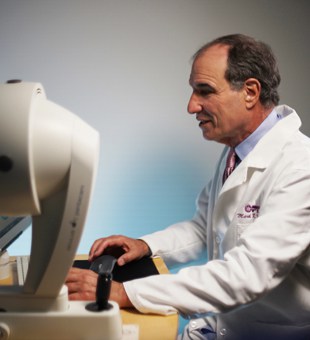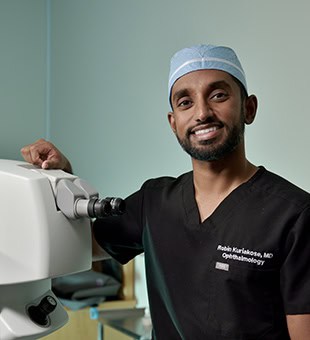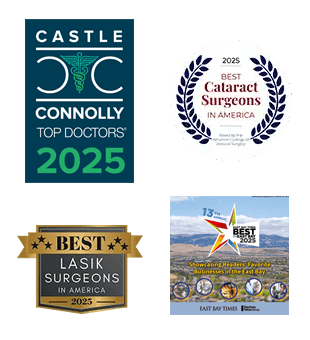Offices in Hayward, Castro Valley and San Jose

What Is a Cataract?
A cataract is a clouding or opacification of the normally clear lens inside the eye. This clouding causes blurred or foggy vision or glare. It is not a visible film or growth over the outside of the eye. The word “cataract” actually means “waterfall” — as if one were looking through a waterfall.
There are two basic types of cataracts:
The slower growing “nuclear” type in which the entire lens turns yellow-brown, and the faster growing “subcapsular” type which affects younger people, those with diabetes, and patients taking cortisone.
How Do I Know If I Have a Cataract?
You will probably notice a decrease in vision and/or glare and halos around lights. You may be unable to see clearly to perform the tasks that you need or want to do. Changes in your eyeglass prescription will no longer improve your vision.
A thorough eye examination by your optometrist and our surgeons can detect the presence of a cataract, as well as other conditions that also may be causing altered vision.
Other reasons for visual loss in addition to the cataract may involve problems with the cornea, the retina, the blood vessels in the back of the eye, or the optic nerve. If these other conditions are present in addition to the cataract, you will likely experience an improvement in vision, but not perfect vision following cataract surgery.
We will explain to you and your family the details of your situation after a thorough exam.
Patients with cataracts may notice one or more of the following symptoms:
- a painless decrease in vision
- light sensitivity or glare
- decreased vision in sunlight
- decreased vision from oncoming headlights
- frequent eyeglass prescription changes
- double vision in one eye
- needing brighter light to read
- poor night vision with glare
- halos, or starbursts
- fading or yellowing of colors
How Is a Cataract Treated?
Surgery is the only way that a cataract can be treated. There are no pills or drops, vitamins, exercises, or lenses that have been shown to prevent or cure cataracts. However, if symptoms from a cataract are mild, a change of glasses may be all that is necessary for you to function more comfortably as the cataract progresses.
Protection from excessive sunlight may help prevent or slow the progression of cataracts. Sunglasses that screen out ultraviolet (UV) light rays or regular eyeglasses with a clear, anti-UV coating offer this protection.
If surgery is required, it is comforting to know that cataract surgery is safe and extremely effective in restoring vision. In fact, cataract surgery has one of the highest success rates of any surgery.
About 2 million people a year have cataract surgery in the United States. Our surgeons are among the most experienced in the country.
Why Cataract Surgery with the Surgeons at Optima Is the Best First Step
Imagine life with less dependence on glasses or contacts; everything in clear, bright, vibrant color. Activities like driving, reading, hiking, biking, swimming and golf are much more convenient. At Optima, this freedom and comfort is precisely what we strive to achieve every day for the people who have chosen to trust their eyes to us.
The center you choose for vision correction should offer advanced technology and experienced surgeons. Our surgeons hold leadership roles in the development of new vision correction technology giving them early access to the latest advances. Our patients often benefit from next-generation technology before it is available anywhere else.
The latest technology is important and it can affect your level of satisfaction with the procedure. However, it’s the surgeon and dedicated staff behind the technology that truly makes the difference. The surgeons and surgical team at Optima have been recognized as leaders in the field, and are continually setting the standard of care that other eye surgeons follow.
As you consider any type of vision correction, you can be confident in our commitment to be there every step of the way to make the process comfortable, and above all, safe and successful.
- Surgery Expectations
- Surgery Options
- Testimonials
- Printable Cataract Brochure
What Can I Expect From Surgery?
At Optima, cataract surgery is performed under local anesthesia at our Federally certified ambulatory surgery center located within our office. Our center was the first outpatient surgery center in the United States to be certified by Medicare and has been in continuous operation since 1981. Because our center specializes only in eye surgery, our highly-trained staff is dedicated to ensuring the highest level of care. We use only state-of-the-art equipment in our warm and comfortable environment.
Before Surgery
Before surgery we communicate with and obtain medical clearance from your primary care physician. During surgery you will be awake, but relaxed. Our anesthesiologist will be at your side. We perform this intricate surgery using a microscope, micro-surgical instruments, and, if the patient chooses, the LenSx femtosecond laser. We were the first site in California to utilize the Alcon Centurion Cataract System which employs the latest technology using ultrasound waves through a small incision to remove your cataract.
After Your Surgery
After cataract surgery, you may return almost immediately to all but the most strenuous activities. We will provide you with written instructions and a helpful guide for the use of eyedrops following your surgery. Several post-operative visits are needed to check on the progress of the eye as it heals.
Cataract surgery is a highly successful procedure. However, it is important to understand that complications can occur during or after the surgery, some severe enough to limit or lose vision.
Fortunately, in our hands, improved vision is the result in over 99% of cases unless there is a pre-existing problem with the cornea, retina, or optic nerve. In approximately 15% of people having cataract surgery, the natural capsule that supports the intraocular lens will become cloudy within 6 to 24 months following surgery. In these cases when part of the cataract “grows back,” the YAG laser is used to painlessly open this cloudy capsule, restoring the clear vision. This is performed as an outpatient procedure at our office.
Conclusion
Cataracts are a common cause of poor vision, but they are treatable. Our experienced surgeons can tell you whether a cataract or some other problem is the cause for vision loss, and help you decide if cataract surgery is appropriate for you. Additionally, we will help you choose the lens implant that best suits your lifestyle. If you elect to undergo surgery, you have an extremely high chance of experiencing greatly improved vision.
Discover How Custom Cataract Surgery Can Help You Get Back to the Life You Once Enjoyed
The focusing power of your eye is restored by replacing the cataract with a permanent intraocular lens implant (IOL). We often use multifocal implants that allow both distance and near, or distance and intermediate vision if the patient desires. If one has astigmatism, we can use an astigmatism (toric) implant and/or the LenSx laser to decrease the astigmatism. In most cases, sutures are not needed.
Due to advances in medical technology, we now have a number of choices for the type of advanced lens implants which will be placed in the eye. (Read about lens options in the following section.) The physicians and staff at Optima are here to help you make the choice, but ultimately, the choice of which implant to use is up to the patient and the family.
To learn more about cataract surgery, including whether you may be a candidate for traditional or laser-assisted cataract surgery, contact our practice today to set up a consultation. Call 510-886-3937 today!




